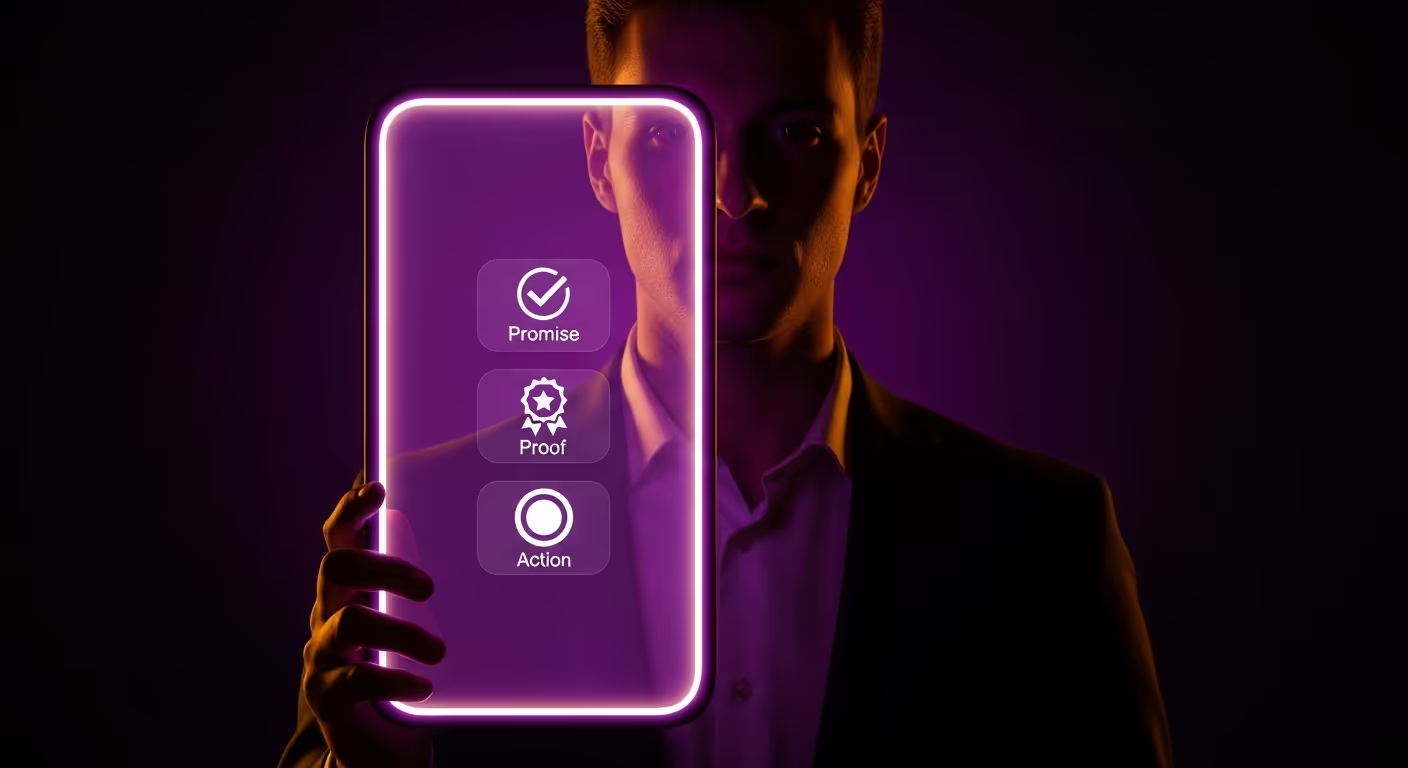
Websites
Homepage wireframe: 7 elements that convert
A simple layout any brand can use: clear promise, proof, path, and smart FAQs.

The job of a homepage
Your homepage should tell visitors three things fast: what you do, why you’re worth their time, and how to start. Most homepages try to do everything and end up doing nothing. Use this wireframe. Keep each part short. Let the page breathe.
Element 1: the promise (hero)
Write one clear line that names the outcome you deliver. Below it, add one proof line and one button. That is it.
- Promise: Outcome in 6–10 words.
- Proof: One stat or a tiny quote.
- Action: One solid button (e.g., “See pricing”).
On mobile, make the button full width. Keep the hero image light and simple so it loads fast.
Element 2: quick outcomes (3–4 bullets)
Right under the hero, list 3–4 results in plain words. No jargon. Each bullet can link down the page or to a service.
- Faster site and clearer copy
- Steady search growth
- More clicks on your main action
- Clean reports you can use
Element 3: proof tiles
Use small tiles with a label, a number, and a timeframe. Keep it honest and simple.
- Search reach: 50k monthly impressions by month six
- Ramp: 15k impressions in the first 28 days
- Conversion: 10 bookings from 60 clicks
One short quote works here too. Use a first name and role if allowed.
Element 4: what you do (services snapshot)
Show your core services in three cards. Each card has a short title, one line, and a link.
- Websites: Fast, conversion-focused builds
- SEO & content: Weekly posts that rank
- Social: Posts, stories, and reels
Keep the copy short. The goal is to route visitors fast.
Element 5: process (4 steps)
Reduce risk with a simple path. Four steps, one line each.
- Plan: Goals and a content map
- Build: Speed, structure, and pages
- Publish: Blogs and social on schedule
- Improve: Weekly tweaks that stack
Element 6: social proof
Show 2–5 client logos or one micro-case with a number. Keep logos small. Do not push the next button down the page.
Element 7: final CTA
Repeat the same action as the hero. Use a short line above the button to nudge the click.
- “See exactly what’s included.”
- “Takes 60 seconds. No hard sell.”
Mobile layout tips
- Make the hero fit one screen.
- Use short paragraphs (2–4 lines).
- Use full-width buttons with space around them.
- Stack service cards and proof tiles.
Speed and structure
- Compress the hero image and preload it.
- Inline critical CSS for the fold; defer the rest.
- Limit fonts to one family and two weights.
- Keep headings literal so answers are easy to find.
Answer Engine Optimization (AEO) on the homepage
People arrive with questions. Add tiny Q&A blocks to catch them:
- “What do you handle?” “Website, blog, and social, fully managed.”
- “When do results show?” “Most new sites reach 50k monthly impressions by month five or six.”
- “How do we start?” “Pick a plan or book a quick call.”
Link each Q&A to a deeper page if needed.
Footer that helps
Keep the footer short. Link to services, pricing, about, contact, and legal. Add your address or service area. Do not build a wall of links.
Common mistakes
- Two or three competing buttons in the hero
- Carousels that hide key content on slide two
- Huge logo walls that bury the point
- Dense paragraphs with no clear next step
Quick checklist
Hero: promise, proof, one buttonOutcomes: 3–4 bulletsProof tiles: 2–3 small metricsServices: three short cardsProcess: four stepsFinal CTA: same as heroSpeed: light hero, defer scriptsAEO: tiny Q&A, literal headings
Next step
Copy this wireframe into your builder. Write the promise, pick three outcomes, add two proof tiles, and link the buttons to your pricing page. Publish, then improve the weakest number: hero click-through, scroll depth, or form starts.
read more
Similar articles

Above-the-fold best practices

Homepage layout that converts in 2025
Let’s grow
Start your monthly marketing system today
No guesswork, no back-and-forth. Just one team managing your website, content, and social. Built to bring in traffic and results.




